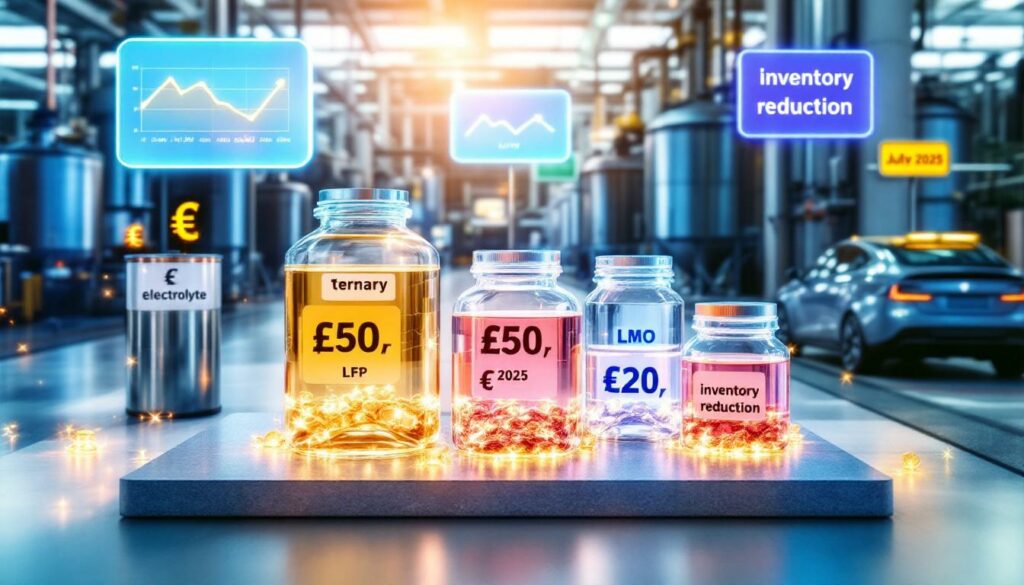What's Happening in the Lithium Battery Electrolyte Market?
The lithium battery electrolyte market is experiencing a notable downward price trajectory as we move through July 2025. According to the latest market data from Shanghai Metal Market (SMM), electrolyte prices have declined across all battery chemistry segments during the period of July 7-10, 2025, continuing a pattern that has battery material suppliers closely monitoring market conditions.
Current Price Trends (July 7-10, 2025)
The price of electrolyte declined this week across all major battery chemistries, with clear differentiation based on battery type requirements:
- Ternary power batteries: 21,750 yuan/metric ton
- LFP power batteries: 17,800 yuan/metric ton
- LMO power batteries: 14,450 yuan/metric ton
This tiered pricing structure reflects the different formulation requirements and performance characteristics needed for each battery chemistry. Ternary batteries (NMC/NCA) typically require more sophisticated electrolyte formulations with specialized additives to manage the higher voltage and energy density, justifying their premium pricing.
Key Market Indicators
Industry analysts at SMM note that electrolyte prices are showing consistent week-over-week decreases across all battery segments. The market is currently characterized by:
- Persistent downward pressure without signs of immediate reversal
- Expectation of range-bound fluctuations in the near term
- Limited potential for significant price recovery without substantial demand catalysts
- Absence of fundamental improvements in the supply-demand relationship
Manufacturers and battery producers are adapting their procurement strategies to navigate this declining price environment, with many taking advantage of favorable pricing to secure medium-term supply agreements.
What Factors Are Driving the Price Decline?
The current electrolyte price decline can be attributed to multiple interconnected market factors rather than a single dominant cause. Understanding these dynamics provides valuable insight into both near-term market conditions and potential future trajectory.
Raw Material Cost Reductions
A key driver behind the falling electrolyte prices is the significant reduction in manufacturing input costs:
- LiPF6 price reduction: This critical salt component, which typically accounts for 30-40% of electrolyte costs, has seen notable price decreases
- Stable solvent costs: The organic carbonate solvents (EC, DMC, EMC, etc.) that comprise the bulk of electrolyte volume have maintained relatively stable pricing
- Additive pricing consistency: Specialty additives that enhance performance characteristics remain price-stable
- Overall manufacturing cost reduction: The combination of these factors has decreased production costs for electrolyte manufacturers
This cost reduction has created both opportunity and pressure for manufacturers. While lower input costs improve potential margins, the competitive market environment is forcing producers to pass these savings to customers rather than retain them as profit.
Weakened Demand Dynamics
The demand side of the equation shows significant softness, particularly in the automotive sector:
- NEV inventory pressure: New energy vehicle manufacturers are facing elevated inventory levels
- Active destocking efforts: Automakers have prioritized reducing existing vehicle stockpiles over maintaining high production rates
- Reduced production enthusiasm: Vehicle manufacturers have scaled back production plans in response to sales challenges
- Month-over-month power battery demand decline: The combination of these factors has resulted in lower battery demand
This automotive market weakness represents a significant shift from the explosive growth that characterized the NEV sector in previous years. With vehicle manufacturers carefully managing production to align with actual consumer demand rather than optimistic forecasts, the ripple effects are being felt throughout the battery supply chain.
Energy Storage System (ESS) Market Influence
Providing some counterbalance to the automotive sector weakness is the growing energy storage system market:
- Overseas ESS growth: International markets are showing strong demand for grid-scale and commercial energy storage solutions
- Partial demand offset: While not completely compensating for automotive weakness, ESS growth is preventing a more dramatic market decline
- Net positive influence: The combination of declining automotive demand and rising ESS demand has resulted in a slight overall market demand increase
This diversification of end-use applications demonstrates the maturing of the battery metals investment landscape beyond its previous heavy reliance on the automotive sector. Energy storage applications frequently have different performance requirements and cost sensitivities compared to automotive uses, creating new opportunities for electrolyte manufacturers to develop specialized products.
How Are Suppliers Responding to Market Conditions?
Faced with challenging market conditions, electrolyte suppliers are implementing strategic adjustments to maintain market position while managing profitability.
Production Strategy Adjustments
Operational flexibility has become paramount for manufacturers navigating the current market:
- "Produce based on sales" model: Manufacturers are increasingly aligning production volumes directly with confirmed orders
- Reduced speculative production: The previous practice of producing in anticipation of future demand has largely been abandoned
- Inventory optimization focus: Careful management of both raw material and finished product inventory levels has become a priority
- Production scheduling efficiency: Manufacturers are implementing more sophisticated production planning to minimize idle capacity while maintaining order fulfillment
This operational approach represents a significant shift from previous periods when capacity expansion and market share growth were the dominant strategies. In the current environment, cash flow management and cost control have taken precedence.
Competitive Pricing Strategies
Price competition has intensified despite already compressed margins:
- Volume discount prevalence: Manufacturers are widely offering tiered pricing based on order volume to secure larger contracts
- Margin sacrifice for market share: Many producers are accepting lower per-unit profits to maintain customer relationships and production volumes
- Aggressive new customer acquisition: Some manufacturers are using particularly competitive pricing to displace competitors and expand their customer base
- Long-term contract negotiation: Forward-looking suppliers are proposing extended contract terms at favorable pricing to secure revenue visibility
The willingness of manufacturers to implement these pricing strategies despite already compressed margins highlights the severity of the structural overcapacity issues facing the sector. With total industry production capacity significantly exceeding current demand, price competition has become the default market behavior.
What's the Market Outlook for Electrolyte Prices?
Looking ahead, several factors will influence the trajectory of electrolyte pricing in the coming months.
Short-Term Price Projections
Market analysts anticipate:
- Continued range-bound fluctuations: Prices are expected to move within a defined band rather than showing decisive directional movement
- Limited upside potential: Without significant demand catalysts, meaningful price recovery appears unlikely in the near term
- Cost-driven pricing: Manufacturers will likely continue passing cost reductions to customers due to competitive pressures
- Persistent pricing pressure: The fundamental market imbalance is expected to maintain downward pressure through the current quarter
This outlook suggests that battery manufacturers and NEV producers can likely plan for stable or slightly declining input costs from electrolytes, providing some cost certainty in their own production planning.
Industry Structural Challenges
Beyond immediate market conditions, the electrolyte sector faces significant structural issues:
- Significant overcapacity: The industry's production capacity substantially exceeds current market demand
- Utilization rate challenges: Many facilities are operating well below optimal capacity utilization levels
- Market consolidation potential: The combination of pricing pressure and overcapacity increases the likelihood of industry consolidation
- Competitive pressure persistence: The fundamental supply-demand imbalance suggests competitive intensity will continue
These structural challenges indicate that the current market conditions are not merely a temporary phenomenon but reflect deeper industry dynamics that will require time and potential consolidation to resolve.
Factors to Monitor
Key indicators that could signal market direction changes include:
- NEV sales recovery: A sustained upturn in electric vehicle sales would directly impact battery and electrolyte demand
- ESS market acceleration: Faster-than-expected growth in energy storage deployments could significantly alter demand projections
- Raw material price movements: Particularly for lithium compounds that influence LiPF6 pricing
- Production capacity adjustments: Any significant capacity rationalization through facility closures or repurposing
Market participants should maintain vigilant monitoring of these indicators for early signs of potential market inflection points.
How Does This Impact the Broader Battery Supply Chain?
The electrolyte price decline has implications that extend beyond the immediate market to affect the entire battery supply chain.
Implications for Battery Manufacturers
For cell and battery pack producers, the current market presents both opportunities and considerations:
- Input cost benefits: Reduced electrolyte pricing provides direct cost advantages for battery manufacturers
- Margin improvement potential: Lower material costs can either improve profitability or enable more competitive end-product pricing
- Negotiating leverage: The buyer's market conditions provide battery makers with stronger positioning in supply negotiations
- Quality considerations: Battery manufacturers must balance cost advantages against potential quality risks from suppliers facing margin pressures
Industry Insight: "While electrolytes typically represent only 5-10% of total battery cell costs, they have disproportionate impact on cell performance and safety. Battery manufacturers must balance cost advantages against potential compromises in electrolyte formulation or quality control that could affect long-term cell reliability." – SMM Market Analysis
Battery manufacturers with sophisticated supplier management systems are in the strongest position to capitalize on current market conditions while mitigating potential risks.
Effects on Electric Vehicle Manufacturers
For NEV producers, the implications are more indirect but still meaningful:
- Battery pack economics: Improved electrolyte pricing contributes to overall battery cost reduction
- Limited direct impact: As electrolyte represents only one component of overall battery costs, the direct impact on vehicle economics is modest
- Supply agreement opportunities: Forward-looking manufacturers can secure favorable long-term supply terms in the current environment
- Inventory management priority: Despite material cost advantages, vehicle destocking remains the primary focus for most manufacturers
The electrolyte price decline represents one positive factor in the broader effort to continue reducing battery costs, which remains critical to achieving price parity between electric and internal combustion vehicles.
FAQ: Electrolyte Market Dynamics
What is causing the current decline in electrolyte prices?
The price of electrolyte declined this week primarily due to three converging factors: reduced raw material costs (particularly LiPF6), weakened demand from NEV manufacturers focused on inventory reduction, and significant structural overcapacity in the electrolyte manufacturing sector. These combined pressures have created a buyer's market where suppliers are competing aggressively on price despite already compressed margins.
How do electrolyte prices vary by battery chemistry?
As of July 2025, electrolyte pricing shows clear differentiation based on battery chemistry requirements:
- Ternary power batteries (NMC/NCA): 21,750 yuan/metric ton
- LFP power batteries: 17,800 yuan/metric ton
- LMO power batteries: 14,450 yuan/metric ton
This pricing hierarchy reflects the different performance requirements, additive packages, and purity standards needed for each battery type. Ternary batteries operate at higher voltages and energy densities, requiring more sophisticated electrolyte formulations with specialized additive packages to manage safety and cycle life.
Will electrolyte prices recover in the near future?
Industry analysis suggests limited recovery potential in the near term due to structural overcapacity issues and the absence of strong demand catalysts. The Shanghai Metal Market (SMM) analysis indicates prices are expected to continue fluctuating within a defined range rather than showing significant upward movement. Any meaningful price recovery would likely require either substantial demand growth or significant production capacity rationalization, neither of which appears imminent.
How is the energy storage sector influencing the electrolyte market?
The growing demand from overseas energy storage systems (ESS) is providing an important counterbalance to the weakness in the automotive sector. While not completely offsetting the decline in automotive demand, ESS growth has prevented a more dramatic market decline, resulting in a slight overall increase in market demand. Energy storage applications often have different performance requirements and cost sensitivities compared to automotive uses, creating opportunities for electrolyte manufacturers to develop specialized products with potentially different pricing dynamics.
Market Insight: The diversification of end-use applications beyond automotive into grid-scale and commercial energy storage represents an important evolution in the battery materials market. Electrolyte manufacturers who can develop formulations optimized specifically for ESS applications may find growth opportunities even in the current challenging market environment.
What strategies are electrolyte manufacturers using to navigate the current market?
Manufacturers are employing multiple strategies to maintain market position while managing profitability:
- Production alignment: Implementing "produce based on sales" operational models that closely match production with confirmed orders
- Volume-based pricing: Offering tiered pricing structures that provide discounts for larger order volumes
- Inventory optimization: Carefully managing both raw material and finished product inventory levels
- Long-term contracting: Proposing extended contract terms at favorable pricing to secure revenue visibility
These approaches reflect a shift from previous growth-focused strategies to a more defensive posture prioritizing cash flow management, cost control, and customer retention.
What are the implications of electrolyte price declines for battery quality?
While lower prices benefit battery manufacturers from a cost perspective, they create potential quality considerations. Electrolyte manufacturers facing margin pressures may be tempted to adjust formulations, reduce additive concentrations, or modify quality control processes to maintain profitability. Battery manufacturers must maintain rigorous supplier qualification and incoming material testing to ensure that cost advantages don't come at the expense of performance, safety, or longevity.
The growing focus on technological improvements like direct lithium extraction and enhanced lithium mining via brines could help reduce upstream costs further. Furthermore, advancements in battery recycling breakthrough technologies and the establishment of a battery-grade lithium refinery in India may create additional supply-side dynamics in the coming years.
Disclaimer: This analysis is based on market conditions as of July 2025 and represents a point-in-time assessment. Market dynamics in the battery materials sector can change rapidly due to technological developments, policy changes, or shifts in end-market demand. Readers should consider this information as one input into their decision-making process rather than as definitive predictions of future market movements.
Want to Capitalise on the Next Major Mineral Discovery?
Stay ahead of market movements with Discovery Alert's proprietary Discovery IQ model, which delivers real-time notifications on significant ASX mineral discoveries across all commodities, including lithium and battery metals. Explore how historic discoveries have generated substantial returns by visiting Discovery Alert's dedicated discoveries page.




